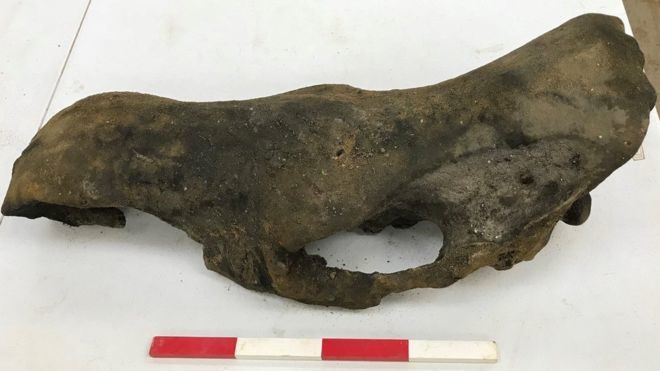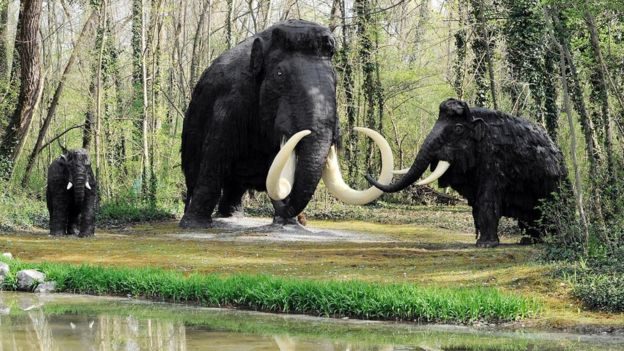BBCFri, 19 Oct 2018 12:17 UTC

The remains are thought to date back to the last Ice Age
Road workers building a new bypass unearthed the Ice Age remains of a woolly mammoth and a woolly rhino.
The team, working on improvements to the A14 between Cambridge and Huntingdon, discovered a number of bones while digging near Fenstanton.
Experts believe the remains,
found in what was once an ancient river, could be at least 130,000 years old.Highways England said the prehistoric bones will be sent to specialists for further analysis.
A Highways England spokesman said: "Remains of a woolly mammoth and a woolly rhino dating back to the last ice age were found last week, while excavating for construction materials near Fenstanton.
"The finds are at least 130,000 years old and were found by what was once an ancient river.
"The remains are being conserved by our archaeology team and will be sent on to specialists in London for further study."
More than £1.5bn of improvements are being made to the A14. The work includes creating a new bypass to the south of Huntingdon and upgrading 21 miles of road.
Woolly facts
- The Woolly Mammoth, or Mammuthus primigenius, was one species of mammoth which went extinct around 10,000 years ago
- They could reach up to 3.5m (11ft 5ins) in height and weigh six to eight tons
- Remains of the woolly mammoth have been found on most continents except for Australasia and South America
- The Woolly Rhinoceros, or coelodonta antiquitatis - meaning cavity tooth - died out in around 8,000 BC
- The species could grow to between 10ft (3.05m) and 12ft 6ins (3.81m) long and 6ft 6ins (2.01m) tall, weighing two to three tons
- The first discovery of the species was made in Poland in 1929; the only prior evidence of its existence was cave paintings.
Comment: As detailed in the article
Of Flash Frozen Mammoths and Cosmic Catastrophes it may be an error to call this rhino 'woolly':
The Woolly Mammoths
The woolly mammoth is a close cousin of the modern elephant. Its size was similar to the African elephant, males reaching shoulder height of about 3 m (10 ft) and weighing up to 6 tonnes.
The mammoths had a plant-based diet and a fully grown male would need to eat about 180 kg (400 lb) of food daily.
[...]
A prejudiced interpretation of the hairy and fatty nature of the creature, and a belief in unchanging climatic conditions led scientists to deem the woolly mammoth a creature of cold areas of our planet. But furry animals don't necessarily live in a cold climate - see, for example, desert animals like camels, kangaroos and fennecs. They are furry and they live in hot or temperate climate
Woolly mammoth "wool", Naturhistorisches Museum Wien
What makes for successful cold adaptation is not fur per se but its erectile nature which traps a layer of air for thermal insulation against the cold. Unlike the fur seal for example, mammoths were devoid of erectile fur.
[...]
The above clearly shows that fur is not a proof of cold-adaptation and neither is fat. Fat only proves that food is plentiful. A fat, overfed dog could not withstand an arctic blizzard and its -80F (-60° Celsius) temperatures. On the contrary, creatures like arctic rabbits or caribous can, despite their relative low fat to body mass ratio.
Mammoths remains are usually found piled up with other animals, like tiger, antelope, camel, horse, reindeer, giant beaver, giant ox, musk sheep, musk ox, donkey, badger, ibex, woolly rhinoceros, fox, giant bison, lynx, leopard, wolverine, hare, lion, elk, giant wolf, ground squirrel, cave hyena, bear, and many types of birds. Most of those animals could not survive the arctic climate. This is an extra indication that woolly mammoths were not polar creatures.
French prehistorian Henry Neuville conducted the most detailed study of mammoth skin and hair. At the end of his thorough analysis, he wrote the following: "It appears to me impossible to find, in the anatomical examination of the skin and [hair], any argument in favor of adaptation to the cold."
- H. Neuville, On the Extinction of the Mammoth, Annual Report of the Smithsonian Institution, 1919, p. 332.
See also:






Comment: As detailed in the article Of Flash Frozen Mammoths and Cosmic Catastrophes it may be an error to call this rhino 'woolly': See also: